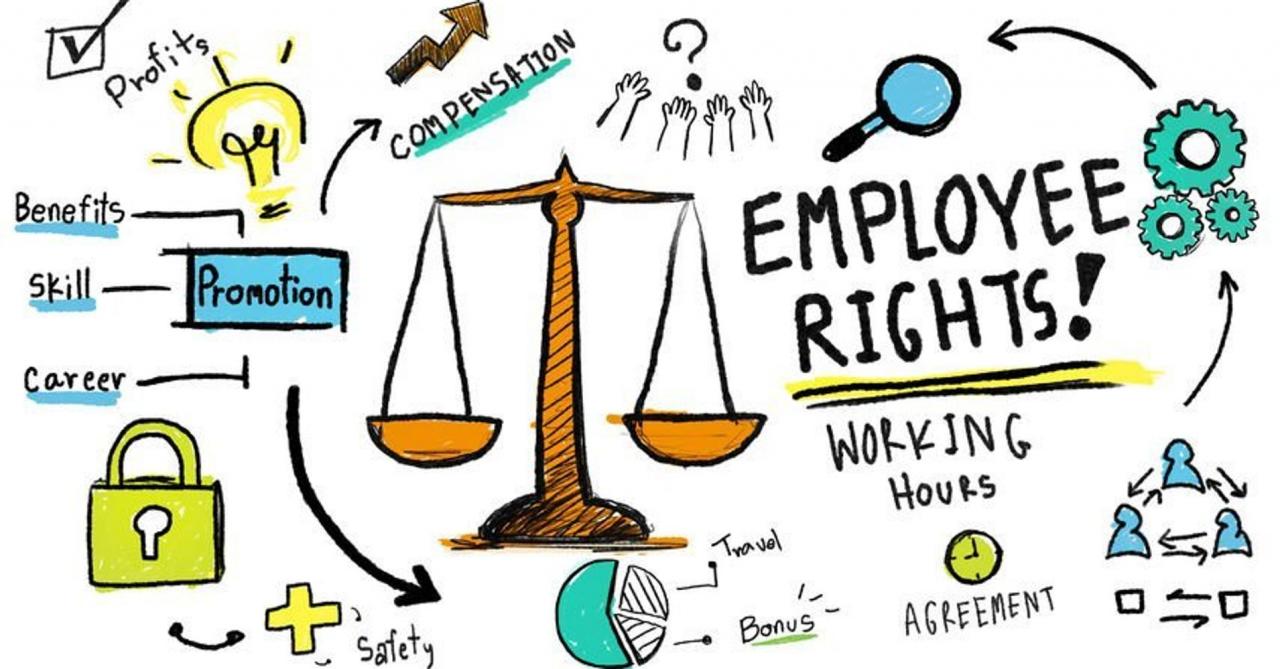In today’s dynamic work environment, understanding your rights as an employee is crucial. The 5 rights of an employee empower you with the knowledge and tools to navigate the workplace with confidence and ensure your well-being, fairness, and growth.
From the right to a safe workplace to the right to participate in decision-making, these fundamental rights protect your interests and create a positive and productive work experience.
The Right to a Safe and Healthy Workplace
The right to a safe and healthy workplace is essential for the well-being of employees and the success of any organization. Employers have a legal and ethical obligation to provide a work environment that protects employees from hazards and promotes their physical, mental, and emotional well-being.
paragraphMaintaining a safe and healthy workplace involves implementing measures that address various aspects of the work environment, including:
Workplace Hazards
- Identifying and eliminating or minimizing physical hazards, such as hazardous chemicals, machinery, and electrical equipment.
- Assessing and controlling chemical and biological hazards, including exposure to toxic substances and infectious agents.
- Ensuring proper ventilation and lighting to prevent respiratory problems and eye strain.
Ergonomic Considerations
- Providing ergonomic workstations and equipment to reduce musculoskeletal disorders, such as carpal tunnel syndrome and back pain.
- Promoting proper posture and work habits to prevent injuries.
- Offering opportunities for movement and stretching to reduce fatigue and improve circulation.
Psychological Well-being
- Creating a positive and supportive work culture that promotes open communication and respect.
- Providing access to resources and support for employees experiencing stress, anxiety, or other mental health concerns.
- Implementing policies and practices that prevent harassment, discrimination, and bullying.
Consequences of Neglecting Workplace Safety
Neglecting workplace safety can have severe consequences for both employees and employers. Employees may experience injuries, illnesses, or even death due to unsafe working conditions. This can lead to lost productivity, increased absenteeism, and higher healthcare costs. Employers may face legal liability, fines, and reputational damage due to workplace accidents or violations of safety regulations.
The Right to Fair Compensation
Fair compensation is the payment employees receive for their work, which is commensurate with their job responsibilities, experience, and the industry standards. It is crucial for employees’ financial well-being and motivation, ensuring they are adequately compensated for their contributions to the organization.Factors
that determine fair compensation include:
- Job responsibilities: The complexity, scope, and impact of an employee’s job.
- Experience: The years of relevant experience and expertise an employee brings to the role.
- Industry standards: The prevailing compensation levels for similar positions within the same industry and geographic location.
Compensation structures vary depending on the organization and industry. Some common structures include:
- Hourly wages: Employees are paid a fixed amount per hour worked.
- Salaries: Employees are paid a fixed amount per pay period, regardless of hours worked.
- Commissions: Employees earn a percentage of sales or other performance metrics.
- Bonuses: Employees receive additional payments based on performance or company profitability.
Each compensation structure has its own pros and cons, and the best choice depends on the specific organization and industry.
As an employee, you have five fundamental rights that protect your well-being in the workplace. To excel in your role and safeguard these rights, check out 15 tips an employee can use to improve . These tips cover everything from communication skills to conflict resolution, empowering you to thrive in your career while upholding your employee rights.
The Right to Respect and Dignity

Respect and dignity are fundamental human rights that should be upheld in all workplaces. They are essential for employee morale, productivity, and overall well-being. When employees feel respected and valued, they are more likely to be engaged, motivated, and productive.
Every employee deserves to be treated fairly and with respect, and that includes knowing their rights. The five basic rights of an employee are the right to a safe workplace, the right to fair pay, the right to reasonable hours, the right to breaks and vacations, and the right to be free from discrimination.
If you’re an employee who’s been misclassified as a 1099 contractor, you may be missing out on these important rights. Learn more about 1099 for an employee and how it can affect your rights as an employee.
Behaviors that Violate Respect and Dignity
There are many behaviors that can violate employee respect and dignity. Some common examples include:
- Harassment: This includes any unwelcome conduct that is based on a person’s race, color, religion, sex, national origin, age, disability, or genetic information.
- Bullying: This is repeated, intentional behavior that is intended to harm or intimidate someone.
- Discrimination: This is treating someone differently based on their race, color, religion, sex, national origin, age, disability, or genetic information.
Policies and Procedures to Foster Respect and Dignity
There are a number of policies and procedures that can help foster a respectful and dignified work environment. Some examples include:
- Anti-harassment and discrimination policies: These policies should clearly define what constitutes harassment and discrimination and provide a process for employees to report and resolve complaints.
- Respectful workplace policies: These policies should Artikel the expected standards of behavior for all employees and provide consequences for violations.
- Training and education: Employees should be trained on their rights and responsibilities under the law and on how to create a respectful and dignified work environment.
The Right to Privacy: 5 Rights Of An Employee

Employee privacy is crucial in the workplace, fostering trust and safeguarding sensitive personal information. It encompasses the right to control the collection, use, and disclosure of information about an employee’s personal life, health, and other aspects.
Various laws and regulations govern employee privacy, including the Privacy Act of 1974, the Health Insurance Portability and Accountability Act (HIPAA), and state privacy laws. These laws set limits on the collection and use of employee information and require employers to implement safeguards to protect data from unauthorized access, use, or disclosure.
As an employee, you’re entitled to certain rights. You’ve got the right to a safe workplace, fair pay, and a chance to speak up. And if you’re interviewing for a new gig, you should ask about these rights, along with other important questions like 10 interview questions to ask an employee . By knowing your rights, you can make sure you’re getting the most out of your job and that you’re treated fairly.
Best Practices for Protecting Employee Privacy
- Data Security Measures:Implementing robust data security measures, such as encryption, access controls, and firewalls, to prevent unauthorized access to employee information.
- Confidentiality Agreements:Requiring employees to sign confidentiality agreements that prohibit them from disclosing sensitive employee information without authorization.
- Limited Data Collection:Collecting only the employee information necessary for legitimate business purposes and limiting the use and disclosure of this information to authorized personnel.
- Employee Training:Educating employees about their privacy rights and responsibilities, including proper handling and disposal of sensitive information.
- Regular Privacy Audits:Conducting regular privacy audits to assess compliance with privacy laws and regulations and identify areas for improvement.
The Right to Voice Concerns and Participate in Decision-Making
Empowering employees to voice their concerns and actively participate in workplace decisions is crucial for fostering a positive and productive work environment. This right ensures that employees feel valued, respected, and have a say in matters that directly impact their work lives.
There are various mechanisms to facilitate employee participation, including employee surveys, suggestion boxes, and employee committees. These channels allow employees to express their ideas, concerns, and suggestions, which can lead to improved workplace policies, processes, and decision-making.
As an employee, you have five fundamental rights. Employers, on the other hand, value certain qualities in their employees. Check out the 10 top characteristics employers look for in an employee and see how they align with your own strengths.
Understanding these characteristics can help you stand out and secure your dream job. Ultimately, knowing your rights as an employee and understanding what employers seek in their workforce empowers you to navigate the job market with confidence.
Employee Surveys
Employee surveys are a valuable tool for gathering feedback from a wide range of employees, providing insights into their perspectives on workplace issues and areas for improvement. By conducting regular surveys, organizations can identify trends, measure employee satisfaction, and make data-driven decisions to enhance the workplace.
Suggestion Boxes
Suggestion boxes offer a confidential and accessible platform for employees to share their ideas and suggestions without fear of judgment or reprisal. These suggestions can range from minor improvements to innovative solutions that can drive positive change within the organization.
Employees have basic rights like fair pay and safe working conditions. However, if you’re classified as a 1099 contractor, you may not have these protections. 1099 as an employee can be a tricky situation, so it’s important to know your rights.
Once you understand your rights as an employee, you can take steps to protect yourself and ensure that you’re treated fairly.
Employee Committees
Employee committees, such as safety committees or quality improvement teams, provide a structured forum for employees to participate in decision-making and problem-solving. These committees empower employees to take ownership of workplace issues and contribute to finding effective solutions.
Benefits of Employee Participation
Encouraging employee participation brings numerous benefits to the workplace, including:
- Improved employee morale and job satisfaction
- Increased employee engagement and productivity
- Enhanced innovation and creativity
- Better decision-making and problem-solving
- Reduced employee turnover and absenteeism
The Right to Training and Development
Providing employees with opportunities for training and development is crucial for their personal and professional growth. It empowers them with the skills, knowledge, and abilities necessary to excel in their roles, contribute effectively to the organization, and stay competitive in the ever-evolving job market.
Training and development programs come in various forms, each designed to address specific needs and objectives. Some common types include:
On-the-Job Training
- Provides hands-on experience under the guidance of a supervisor or experienced colleague.
- Allows employees to learn and apply new skills in a real-world setting.
Classroom Training
- Involves formal instruction in a classroom setting, typically led by an instructor or expert.
- Covers a range of topics, from technical skills to soft skills like communication and leadership.
Online Training
- Offers flexibility and convenience, allowing employees to learn at their own pace and schedule.
- Can include e-learning modules, webinars, and virtual simulations.
Mentoring and Coaching
- Pairs employees with experienced mentors or coaches who provide guidance, support, and advice.
- Helps employees develop their skills, navigate challenges, and advance their careers.
Effective training and development programs should be tailored to the specific needs of the organization and its employees. Best practices include:
Needs Assessment
- Identifying the skills and knowledge gaps that need to be addressed.
- Ensuring that training programs are aligned with the organization’s goals and objectives.
Customized Content
- Developing training materials that are relevant to the specific roles and responsibilities of employees.
- Providing opportunities for employees to tailor their learning experiences to their individual needs.
Engaging Delivery
- Using interactive and engaging training methods to keep employees motivated and involved.
- Incorporating hands-on exercises, simulations, and real-world case studies.
Evaluation and Feedback
- Regularly assessing the effectiveness of training programs and gathering feedback from participants.
- Making adjustments to improve the quality and impact of future training initiatives.
The Right to a Work-Life Balance
Work-life balance refers to the ability of employees to manage their work and personal lives in a healthy and fulfilling way. It involves establishing clear boundaries between work and non-work time, ensuring that employees have adequate time for rest, relaxation, and personal pursuits.
Maintaining a healthy work-life balance is crucial for employee well-being, as it reduces stress, improves job satisfaction, and enhances overall health.Factors that can contribute to work-life imbalance include:
- Excessive workload and unrealistic deadlines
- Lack of flexibility in work arrangements
- Poor communication and boundary setting
- Personal commitments and responsibilities
Strategies for maintaining a healthy work-life balance include:
- Setting clear boundaries between work and non-work time
- Prioritizing tasks and delegating when possible
- Taking breaks and using vacation time
- Engaging in stress-reducing activities
- Seeking support from family, friends, or a therapist when needed
Workplace policies and practices that can support work-life balance include:
- Flexible work arrangements (e.g., remote work, flexible hours)
- Paid time off and sick leave
- Employee assistance programs
- Wellness programs
- Training on work-life balance and stress management
The Right to Due Process
Due process refers to the fundamental legal principle that individuals are entitled to fair and reasonable procedures before being deprived of their life, liberty, or property. In the workplace, due process ensures that employees are treated fairly and have the opportunity to defend themselves against allegations or disciplinary actions.
Due process procedures vary depending on the specific circumstances and the policies of the organization. However, general principles include:
Employee Discipline
- Employees should be provided with clear and written notice of any allegations against them.
- Employees should have the opportunity to respond to the allegations and present evidence in their defense.
- Employees should be given a fair and impartial hearing before any disciplinary action is taken.
Employee Grievances
- Employees should have a formal process for filing grievances and appealing decisions.
- Grievances should be investigated promptly and fairly.
- Employees should be given the opportunity to present their case and have it reviewed by an impartial decision-maker.
Other Workplace Disputes
- Due process principles also apply to other workplace disputes, such as discrimination, harassment, and retaliation.
- Employees should be treated fairly and given the opportunity to defend themselves against any allegations.
- Organizations should have clear and consistent procedures for handling workplace disputes.
The Right to Collective Bargaining
Collective bargaining is a process in which employees negotiate with their employer as a group to improve their working conditions. This right is essential for protecting employee rights because it allows workers to have a say in the decisions that affect their workplace.
Knowing your 5 rights as an employee is crucial, but it’s equally important to understand the qualities employers seek in their team. Check out this list of 10 characteristics employers look for in an employee to up your game and secure your dream job.
Remember, asserting your rights and showcasing these desirable traits will put you ahead in the employment game.
The process of forming and negotiating a collective bargaining agreement (CBA) can be complex. First, employees must form a union, which is an organization that represents their interests. Once a union is formed, it can begin negotiating with the employer on behalf of its members.
Every employee has the right to a safe work environment, fair compensation, reasonable hours, and benefits. These rights are essential for creating a positive and productive work environment. To be an ideal employee, it’s important to go beyond these rights and embody the 15 traits of an ideal employee , such as being proactive, communicative, and adaptable.
By fulfilling these responsibilities, employees not only protect their rights but also contribute to the success of the organization.
CBAs typically cover a wide range of issues, including wages, hours, working conditions, and benefits. The negotiation process can be lengthy and difficult, but it can also be very rewarding for employees. When a CBA is finally reached, it becomes a legally binding contract that both the employer and the union must follow.
Benefits of Collective Bargaining, 5 rights of an employee
- Higher wages and benefits
- Improved working conditions
- Greater job security
- A voice in the workplace
Challenges of Collective Bargaining
- The process can be lengthy and difficult
- Strikes and other work stoppages can occur during negotiations
- CBAs can limit the flexibility of employers
Conclusion

Remember, knowing and exercising your 5 rights as an employee is not just about protecting your individual interests; it’s about creating a workplace culture where everyone thrives, innovation flourishes, and fairness prevails.
Query Resolution
What are the 5 rights of an employee?
The 5 rights of an employee include the right to a safe and healthy workplace, fair compensation, equal opportunity, respect and dignity, and privacy.
Why are employee rights important?
Employee rights are important because they protect workers from exploitation, discrimination, and unfair treatment, ensuring a positive and productive work environment for all.
How can I enforce my employee rights?
If your employee rights are violated, you can file a complaint with your employer, a government agency, or a union representative.